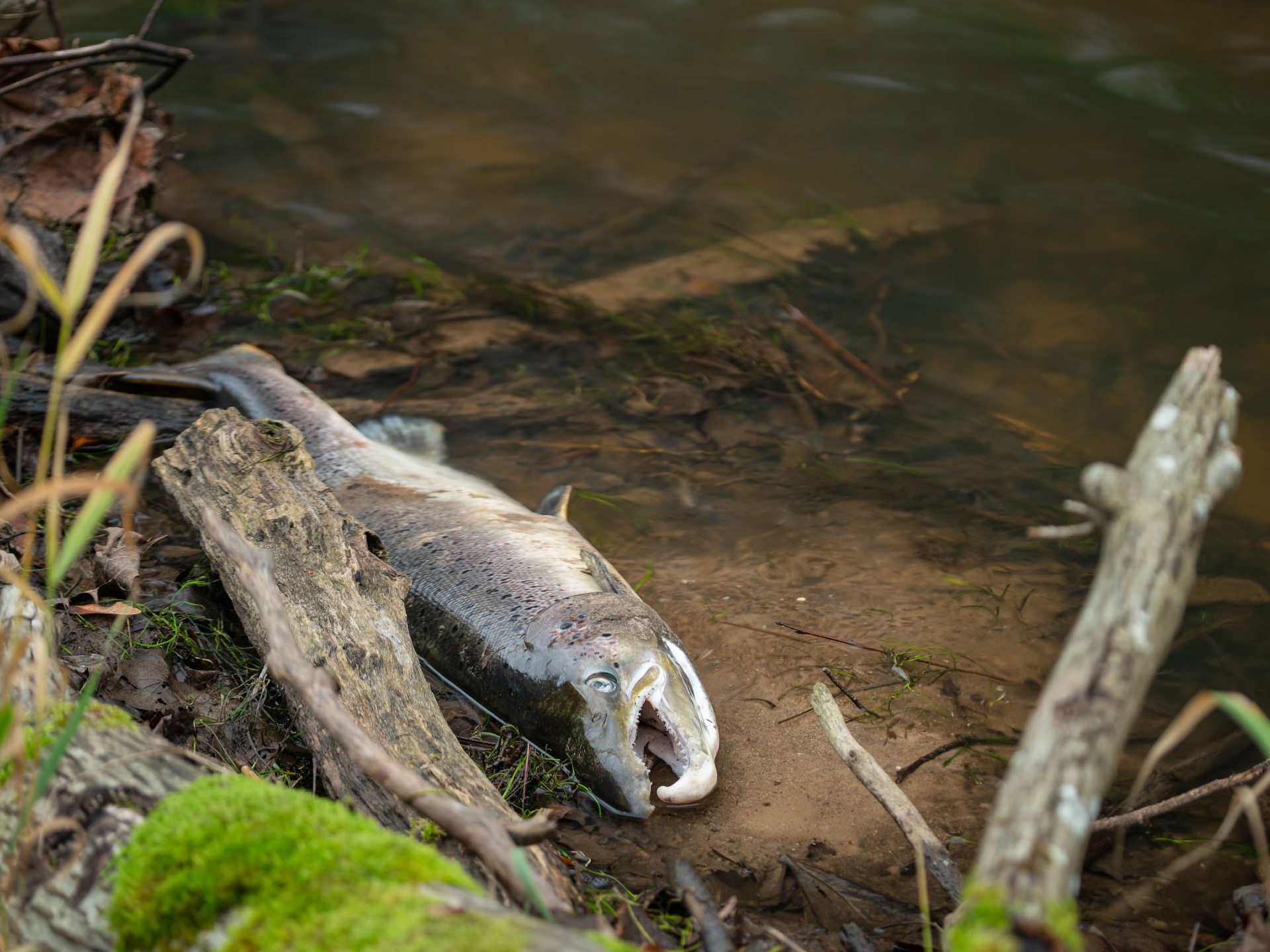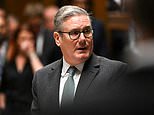
Atlantic salmon populations in England and Wales have plummeted to unprecedented lows, according to the Atlantic Salmon Stock Assessment for 2024, a report published this month by the United Kingdom Environment Agency and Centre for Environment, Fisheries and Aquaculture Science.
According to the report by the two government agencies, a massive 90 percent of wild river salmon in England are classified as either “at risk” or “probably at risk”.
This latest classification is due to salmon stocks declining to levels that are insufficient for a self-sustaining salmon population.
“Forty years ago, an estimated 1.4 million salmon returned to UK rivers each year. We are now at barely a third of that – a new low and evidence of the wider, growing biodiversity crisis,” Alan Lovell, chairman of the Environment Agency, said when the report was released.
At the end of last year, the International Union for Conservation of Nature (IUCN), an international organisation dedicated to nature conservation, changed the status of Atlantic salmon from “least concern” to “endangered” in Great Britain on its Red List of Threatened Species.
“There are rivers that used to have in the UK maybe 20,000 to 30,000 Atlantic salmon running them, and they’re now down to 1,000 to 2,000, and there are some rivers with literally a few hundred left,” Dylan Roberts, head of fisheries at the Game & Wildlife Conservation Trust in the UK, told Al Jazeera.
“We’re looking at about an 80 percent decline over the last 40 years in wild Atlantic salmon.”

Why is Atlantic salmon endangered?
In December, Atlantic salmon was classified as endangered due to a 30 to 50 percent decline in British populations since 2006 and a 50 to 80 percent projected decline from 2010 to 2025, according to the IUCN.
The IUCN’s Red List of Threatened Species has nine categories based on risk of extinction. These classifications help the wider scientific community assess and monitor the conservation status of different species.
They are the following:
- Not evaluated: species that have not yet been assessed against the IUCN criteria
- Data deficient: species for which there is insufficient information to make a direct or indirect assessment of their risk of extinction
- Least concern: species that are widespread and abundant and do not qualify for any higher risk category
- Near threatened: species that do not currently qualify as threatened but are close to qualifying for a threatened category in the near future
- Vulnerable: species facing a high risk of extinction in the wild
- Endangered: species at very high risk of extinction in the wild
- Critically endangered: species that face an extremely high risk of extinction in the wild and meet criteria indicating an imminent threat to their survival
- Extinct in the wild: species that survive only in captivity or outside their natural range and are presumed extinct in their native habitat after exhaustive surveys
- Extinct: species for which there is no reasonable doubt that the last individual has died, confirmed by extensive surveys without sightings
The IUCN’s Red List includes more than 45,300 species that are threatened with extinction, which includes any species in the classifications from vulnerable to extinct in the wild.
According to Roberts, species do not automatically make the IUCN’s Red List just because of low numbers. What gets a species on the list is how sharp the slope of decline is.
“The slope on salmon is endangered. Hence they went on the red list. You’re looking at quite dramatic declines,” he said.
Why are salmon faring so badly in UK rivers?
Agricultural practices
Salmon habitats globally face multiple threats, including agricultural pollution, increased sedimentation on riverbeds, chemical run-off from industrial activities, wastewater discharge and even disruption of rivers due to new road infrastructure.
Additionally, structural barriers built in rivers that impede migration routes, water scarcity due to excessive use and rising ocean temperatures caused by climate change further endanger salmon ecosystems.
Bycatch
European and British salmon travel along a migration route through rivers and streams known as the “smolt superhighway” as they head north to feed into the North Atlantic.
Peak migration time when many of these young fish are heading through this superhighway is around May and June. At this time, young salmon often get caught by large trawlers entering in the same zone in the sea to catch other fish such as mackerel or herring.
This directly reduces the number of fish that can grow to adulthood and return to their natal rivers to spawn.
Bycatch refers to catching fish that are not the main target for trawlers. “Bycatch would be the accidental capture of things like seals, seabirds, dolphins, whales, sharks, rays, skates and [are] protected,” Roberts said. “All these species are recorded. The problem is that salmon just aren’t recorded. And other protected fish as well, such as sea trout, which go to sea.”
According to Roberts, a solution to this problem is to collect better data on how salmon are moving through the rivers and oceans to get a better sense of the impact on the population.

Maize production
The environmental impact of maize production in the UK has proven to be another factor that has adversely impacted rivers and streams vital to salmon. The growth in the use of maize in biofuels and cattle fodder has exacerbated the problem.
“The habitat has been destroyed by intensive agriculture and all the algae and the sediment run-off. So you get this filamentous algae growing on the riverbed, and the riverbed just gets smothered with it,” Roberts said.
The overproduction of algae is detrimental to insects and invertebrates that live in the river and on which salmon are dependent as a food source.

Can salmon farming make up for these losses?
Not really and, in some cases, it may be making the situation for salmon stocks worse.
According to some estimates, roughly 70 percent of the world’s salmon is produced through salmon farming and not caught in freshwater streams.
Salmon farming in the UK generates 1.5 billion pounds ($1.95bn) a year in revenues.
Some experts argue that vast numbers of salmon raised in cramped conditions in aquaculture facilities pose significant challenges and health risks. These practices not only impact the welfare of the salmon but also carry implications for human health and environmental sustainability.
Intensive salmon farming coupled with cramped conditions in farming sea cages can result in the salmon being more susceptible to catching diseases.
“You end up with disease problems – viruses, biological sea lice, sea lice problems – then all the waste that goes into these lochs because they’re in sheltered areas. They don’t get a full flushing from the tides, and over time, they build up,” Roberts explained.
“And what they’re finding now in these lochs is that they’re getting eutrophication [a build-up of algae]. So the locks are turning green, and that’s killing the fish in the cages,” he added.
Eutrophication is often caused by agricultural practices and can cause salmon to experience hypoxia, a depletion of oxygen levels. This can happen to both wild salmon and farmed salmon.
Salmon sometimes escape from the aquaculture farms through nets damaged by severe weather, just being worn down or via poorly secured drains.
Once these escapees from the “fish asylum” are in freshwater rivers and streams, they can interbreed with wild salmon, disrupting their natural development and passing on diseases.
“If you upset the genetic gene pool, that’s a big problem,” Roberts said.

According to a 2023 annual fish health report from the Norwegian Veterinary Institute, roughly 17 percent of the country’s farmed salmon died due to infectious diseases. Norway is the top producer of salmon, contributing roughly 50 percent of global production.
Diseases can range from winter sores to heart skeletal muscle inflammation. Although there are treatments for some of these diseases, the treatments themselves can weaken fish, making them even more susceptible to other infectious diseases.
“Infectious diseases are an extensive problem both for the fish’s welfare and survival in the sea,” said Edgar Brun, department director at the Veterinary Institute.
However, industry experts say finding the right preventive measures to reduce disease in fish remains challenging. Moreover, the overuse of vaccines can increase antibiotic resistance, making certain pathogens more entrenched in the salmon population.
Is salmon endangered in other parts of the world as well?
In Ireland and Iceland, overfishing and habitat destruction have led to significant declines in the salmon population.
According to Inland Fisheries Ireland, an organisation responsible for protecting inland fisheries and sea angling resources, wild salmon numbers returning to Ireland dropped from 1.76 million in 1975 to 171,700 in 2022.
In the US, specific species, including Chinook and Coho salmon, have endangered status due to overfishing, pollution from agricultural run-off and urban development.
In Canada, the fourth largest producer of salmon, production has fallen from a peak of 148,000 tonnes in 2016 to 90,000 tonnes in 2023, according to the Canadian Aquaculture Industry Alliance. Many experts attribute some of the decline to hundreds of thousands of salmon escaping from sea cages and spreading diseases to the wild stock.

Should we all stop eating salmon?
Until recently, salmon was considered a luxury food in many parts of the world. These days it is eaten much more frequently, and many experts say we eat too much of it.
Although salmon is often celebrated by health experts for its omega-3 fatty acids, which are beneficial for heart health, there is a risk of overconsumption, given the levels of freshwater contamination and diseases that can become pervasive in fish farms, causing populations to fall.
Some farmed salmon has more omega-3 fatty acids than wild salmon but can have high levels of polychlorinated biphenyl (PCB). PCBs are synthetic chemicals that have widespread industrial uses. PCBs can “live” in industrial waste that gets dumped into our seas, rivers and streams. PCBs tend to be more prevalent in closed-system environments than open environments, like freshwater rivers.
Many health experts recommend eating wild salmon because of their lower levels of PCBs. Freshwater salmon also tend to be less susceptible to those fish-related diseases that are more common in farm-raised salmon.
According to Roberts, encouraging people to eat less salmon would not be particularly practical.
However, he said, collaboration with organisations like the Missing Salmon Alliance, which brings together other NGOs that advocate for sensible production of salmon while preserving the salmon ecosystem, can help put pressure on governments to implement more stringent rules for fisheries to preserve current populations and increase salmon populations.

Are other fish species in danger as well?
According to Roberts, another endangered fish is the eel. The conditions that have endangered salmon are very similar to those that are threatening eels: overfishing, habitat destruction, pollution and climate change.
Eels are an important food source for mammals that live around rivers and streams, including minks and otters. Smaller eels are an important food source for birds too.
Due to low eel populations, the European Union implemented regulations on eel fishing in 2018.
According to a May report from the European Parliamentary Research Service: “The European eel (Anguilla anguilla) has suffered a 90 percent to 95 percent decline in its population since the 1980s. Within 50 years, the European eel has turned from one of the most abundant freshwater fish to an endangered species.”
How is climate change contributing to this?
Rising water temperatures as a result of climate change pose significant challenges for salmon. As the water warms, its oxygen content decreases, making breathing more difficult for these fish. Consequently, salmon must swim greater distances in pursuit of nourishment and cooler waters, further taxing their already strained systems.
According to Roberts, warmer waters destroy some nutrients in oceans and rivers, which affect food chains. Atlantic salmon typically eat zooplankton, blue whiting, sand eels, small insects, insect larvae and small crustaceans called amphipods or scuds. As food for the salmon becomes more scarce, this can have a negative impact on the size of the salmon.
Smaller salmon produce fewer eggs. Fewer eggs mean a decrease in the overall population.
“Now, as it grows, it gets faster, more powerful. It can evade predators, but if they grow more slowly, they’re more vulnerable to predation,” Roberts said. “And what we found is that the decrease in the growth rate of salmon is most marked during their first summer at sea.”






